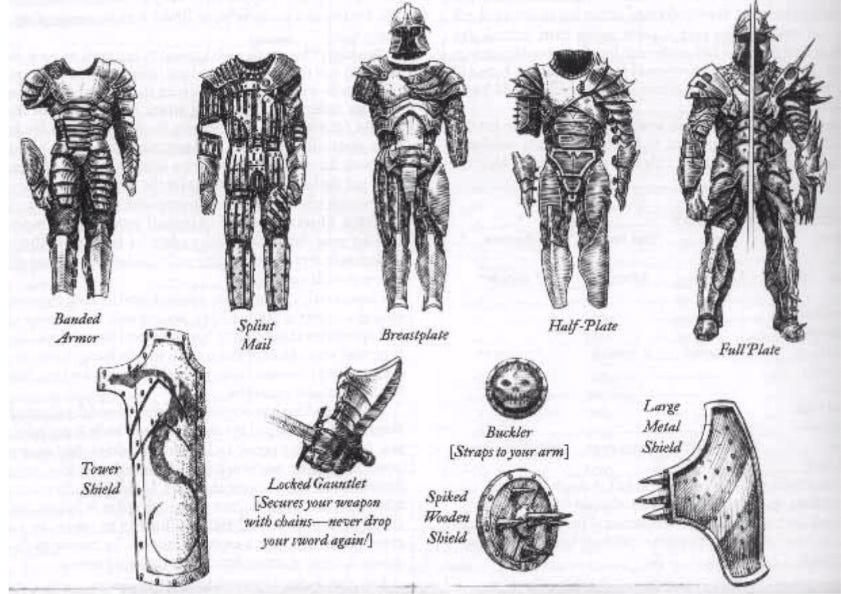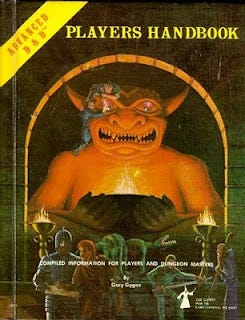Beyond D&D -- Simulating Armor in Role Playing Games
Roleplaying Games Represent the Effects of Armor a Variety of Ways
In the almost 50 years that commercial role playing games have been around, a number of traditional mechanics have evolved to simulate how armor protects individuals in combat situations. Almost immediately after the publication of the Dungeons & Dragons “little brown books,” people have debated the merits of various combat systems and which more realistically emulates the underlying "physics" that ought be emulated by a rules set -- the important word being "ought." The mechanical preferences of players and systems is in part due to the fact that different games not only represent different time periods, they sometimes represent different genres that can have very different levels of lethality when it comes to the combats being simulated.
Underpinning the vast majority of role-playing game combat systems is a set of “dials” that can be manipulated in different ways in order to capture different “narrative” flows during “in game” combat. These dials can even be broken down into sub-dials as well. The four most commonly used dials are Chance to Hit, Weapon Damage, Character Damage Adjustment, and Damage Reduction (often from armor). How these are applied can vary, for example the percentage chance to hit in some systems is a combination of a hit roll and dodge/resist roll.
As Rick Priestley points out in his excellent book Tabletop Wargames: A Designers’ and Writers’ Handbook, having a to hit roll followed by a dodge/resist roll is effectively the same as a percentile to hit system. Rick Priestley is a legendary game designer who worked on early Warhammer Fantasy Battle and Warhammer 40k rules systems in addition to decades of other work, and he knows his stuff. I highly recommend his book as he goes into some detail showing how he took earlier percentage tables and converted them into the “did you hit, did it bypass their toughness, did their armor resist it” system. Three rolls to achieve a single percentage outcome. This is essentially transforming the percentage chance to hit dial into three sub-dials, but the outcome of a percentage chance to have an effect on an opponent is the same. Additionally, the average amount of damage per attack can be represented as a linear equation in all of the systems that use these dials.
I’ll take a moment to acknowledge that there are some highly narrative storytelling games that don’t quite fit this mold, but for role-playing games where combat is tactical in mechanics this tends to be the norm.
There are a wide variety of ways that the effects of armor can be emulated, but I have found that there are four basic mechanical structures that have been used to simulate the effectiveness of armor in combat.
Armor Class/Target Number systems.
The first role playing game to utilize an Armor Class system was the Dungeons & Dragons role playing game -- the first commercially available role playing game. In a "pure" Armor Class system, the armor the character is using affects how difficult the individual character is to hit in combat. In these systems, characters in better armor are harder to hit than characters in "worse" armor. Also factored into a character's Armor Class is how agile a character is, and thus how adept they are at physically avoiding damage. The the to hit, to dodge, and to resist functions are merged into a single abstract construct, Armor Class.
The system used in Dungeons & Dragons has its roots in the combat resolution matrices used in the Chainmail miniatures game with an added “hit point” component like the one used in Ironclads (apparently the actual game was Don’t Give Up the Ship which uses a combination of “sail factors” and “tonnage” to simulate hit points). The Chainmail table was similar in many ways to older tables used in both miniature and non-miniature wargames ranging from Tony Bath’s miniature rules to Panzerblitz. These tables compare an offensive skill value/weapon being used to an opponents defensive value/armor and provide a numerical value representing the probability of hitting/killing an opponent. Just as a tank in Panzerblitz might have a defensive value of 6, a warrior in an Armor Class system might have an Armor Class of 6.
The average damage that any character receives during any given combat round in one of these systems can defined by the following linear equation:
Damage = (Probability of an attack hitting )* (average weapon damage + damage bonus - 0 (Damage Reduction))1
In these systems, armor reduces damage by reducing the probability of you taking damage. If someone has a 50% chance of hitting you with a weapon that does an average of 3.5 damage, then that person does 1.75 hit points of damage on average to your character. Obviously, they don’t actually do 1.75 damage per round. Instead, they either “hit” you and do damage or “miss” you and fail to do damage. The point here is the blow by blow of combat is abstracted to include both armor’s ability to prevent you from being hit AND its ability to reduce damage in a single mechanic. It’s an elegant system, but when you see it in practice you can see how it misses on some of the narrative back and forth of other combat systems. By collapsing the to hit, to dodge effects, and to resist effects into a single percentage, you speed up play but lose descriptive nuance.
Damage Reduction systems.
For many, the abstract nature of an Armor Class system seems less than intuitive and is less than satisfactory. To some, it doesn't seem intuitive that armor "makes you harder to hit," instead in can be viewed as reducing the amount of damage that a particular attack does when it hits. The first role-playing game to use a Damage Reduction system was Tunnels & Trolls, the second role-playing game published. Tunnels & Trolls has a highly abstracted combat system where players roll pools of dice, but those are still a variation on the percentage chance to hit system.
One of the most famous to do so is Chaosium’s Runequest role-playing game. Damage Reduction systems vary in their complexity and end results. In some systems like The Fantasy Trip or Dragonquest, armor not only reduces the amount of damage your character takes from a blow, but it might actually decrease your own combat effectiveness as the system emulates how much a bulky suit of armor might affect your own combat capabilities. In these systems, there can be certain suits of armor that render certain weapons entirely ineffective as the maximum damage they can cause is less than the Damage Reduction value of certain suits of armor. This was not the case with Tunnels & Trolls, but has been for others.
The damage that any character receives during any given combat round can defined by the following linear equation:
Damage = (Probability of an attack hitting)*[average weapon damage + damage bonus - Damage Reduction]2
The equation for Tunnels & Trolls is a little different since the weapon damage and skill with the weapon are collapsed into a single die pool where the player with the higher total does the difference in damage to the other opponent, effectively transforming the first two dials into a single dial.
Armor Penetration systems
A variant of Damage Reductions systems are those systems where armors have an Armor Value that must be exceeded by a roll of a weapon's Penetration die. The innovative RPG Dragon Warriors uses this system for its damage determination. In this system while the value of the protective value of the armor, and the damage rating for any weapon, is static, the chance that the armor prevents damage is a variable number. In this case, the armor doesn't prevent the character from being "hit," nor does it reduce the amount of damage done. Instead, the armor acts as a barrier that either blocks all the damage of a "hit" or none. Like the earlier Damage Reduction system, there are circumstances where a given armor might be impossible to penetrate with certain weapons.
The damage that any character receives during any given combat round can defined by the following linear equation:
Damage = ((Probability of an attack hitting)*[Probability of weapon bypassing armor's Armor Value]*[Weapon Damage])
For example, Sir Hereward has a 50% chance of hitting Ambassador Vyle with his longsword. Sir Hereward is attacking with a longsword (d8 penetration and 4 damage), and Vyle is wearing chainmail (AV = 4). Assuming that Sir Hereward has no bonus to his penetration roll from Strength or magic, his longsword would penetrate Vyle's chainmail on a roll of 5,6,7, or 8 on an eight sided die (50% of the time)his average damage to Vyle would be:
Damage = ([.5]*[.5]*[4]) or an average of 1 point of damage per attempted attack. Any successful attack would automatically do 4 points of damage.
Combination Systems
The majority of the remaining systems appear to be combinations of the above mechanics. The Palladium Fantasy Role Playing Game uses a variation of the Armor Class system, but it adds an additional layer. Not only does armor make it harder for you to be hit, but if the armor is the reason you weren’t hit any damage you would have suffered is absorbed by the armor which can be destroyed if it takes enough damage. The GURPS game uses a Damage Reduction system that also includes a "Passive Defense" system that allows for armor to make an opponent miss outright. The Hero System series of games -- because of their effects based nature -- actually use both systems. One could represent Armor in Hero as either reducing the chance to hit, or reducing the amount of damage done -- though the system always includes some element of a Damage Reduction system. This is also true of Green Ronin's excellent Mutants & Masterminds game system (and their True 20 system as well), which uses both an Armor Class system and a Damage Reduction system and can have armor simulated either way. Games like Mayfair's sadly out of print DC Heroes role playing game have armor work in a modified Penetration system.
From the above discussion, you can see that regardless of the expressed preferences of those who use Armor Class Systems, Damage Reduction Systems, or Armor Penetration Systems, the average damage per attempted attack can be expressed in a similar linear equation for each. That equation being:
Damage = [chance of doing any damage]*([average damage] - Damage Reduction) with a floor of 0 on damage.
Even D&D uses this equation, it's just that the Damage Reduction is always equal to zero. The Advanced Dungeons & Dragons game did attempt to add some granularity to this linear equation through the use of a weapon vs. armor modification chart which added or subtracted from the probability to hit based on which weapon was being used against which specific armor. This system wasn't widely used for a number of reasons, not the least of which were that it was unduly complex and that it didn't include sufficient modifications for weapon use against monsters.
As an aside, one could argue that DC Heroes and Tunnels & Trolls are some of the few games that break completely free of the simple linear damage equation I gave above. It still can be represented in a linear equation, but the variables are modified based on a hit and damage resolution tables that aren't purely linear in its expressions.
Which is your preferred Armor simulation system?
Are there any simulation methods I left out that you admire?
This equation has been edited to put damage reduction within the same parentheses as damage because damage reduction is only applied when an individual is hit in combat. This change re-enforces the concept that AC and Damage reduction are dials emulating the same thing and that they behave similarly and as one has less influence (AC on ‘to hit’) the other has more effect (Damage Reduction). One odd thing about my initial error is that if it was correct, armor would heal characters when they are missed in combat. This is not how Damage Reduction works at all, but it might make for an interesting game in its own right.
See Footnote 1











Interesting article, thanks. I favour the first, and simplest version, as used by D&D, where armour and chance to hit are combined.